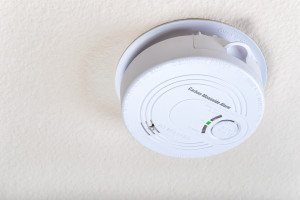Carbon Monoxide
Expand All Collapse All
- What is it?
- Symptoms
- First Aid
- Prevention
What is it?
What is carbon monoxide?
Carbon monoxide, also known as CO, is a harmful gas that you cannot see or smell. Carbon monoxide is made when fuels like wood, oil and coal are burned.
 A carbon monoxide alarm is your No. 1 tool for avoiding carbon monoxide poisoning. A carbon monoxide alarm is your No. 1 tool for avoiding carbon monoxide poisoning. |
You can breathe in carbon monoxide if your appliances or equipment are broken, or if you use them in the wrong way. Some types of equipment that make carbon monoxide are:
- Fireplaces
- Furnaces
- Generators
- Grills
- Space heaters
Symptoms
What are the symptoms of carbon monoxide poisoning?
You can breathe in carbon monoxide and not even know it until you have symptoms. A carbon monoxide alarm will let you know if you have too much in your home.
When you breathe in carbon monoxide, your brain and heart don’t get enough oxygen. Early symptoms may feel like having the flu. You may:
- Have a headache
- Feel tired
- Have trouble breathing
- Feel sick to your stomach or throw up
If you breathe in a lot of carbon monoxide, you could:
- Have trouble thinking
- Have a heart attack
- Go into a coma, or even die
First Aid
What can I do about carbon monoxide poisoning?
If your carbon monoxide alarm is going off, or if you think you have breathed in carbon monoxide:
- Get to fresh air right away
- Call 911 or your local fire department
- Contact the poison center for first aid advice while waiting for the fire department to arrive. Call 1-800-222-1222 or text POISON to 85511.
Prevention
How can I prevent carbon monoxide poisoning?
To prevent carbon monoxide poisoning:
- Put carbon monoxide alarms in your home:
- Place an alarm near each sleeping area of your home, with at least one alarm on every floor.
- Read the directions that come with the alarm. They will tell you where to put the alarm, how to use it and how often to check the batteries.
- Put batteries in all your alarms. If the power goes out, plug-in alarms will not work without batteries.
- Have a professional set up your furnace, hot water heater or stove. Make an appointment to have a professional check on the furnace once a year.
- Do not leave your car running in a garage, even with the garage door open.
- Use outdoor equipment outside, away from windows and doors. Do not use generators, grills or gas-powered tools indoors or near windows or doors.
- Use generators safely:
- Only use your generator outside.
- Put the generator more than 20 feet away from your house and your neighbors’ houses.
- Point the exhaust away from houses.
- To prevent a fire, have an electrician help you choose and set up your generator.
- Clear your outdoor heating vents after a snowfall. Also be sure your vehicle’s tailpipe is clear before starting it.
Last Updated: Friday May 6th 2016


 A carbon monoxide alarm is your No. 1 tool for avoiding carbon monoxide poisoning.
A carbon monoxide alarm is your No. 1 tool for avoiding carbon monoxide poisoning.


